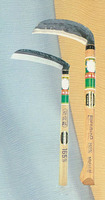

Total:131items
- Pottery & Porcelain (18)
- Lacquerware (4)
- Glasswork (2)
- Wood & Bamboo Work (19)
- Leather Work (1)
- Papermaking (13)
- Textile (20)
- Dyeing products (5)
- Masonry (1)
- Metal Work (11)
- Satsuma Suzuki: Satsuma Tinware
- Tosa Uchihamono: Tosa Blade
- Kaga Zougan: Kaga Inlay
- Akita Ginsen Zaiku: Akita Filigree
- Token: Japanese Sword
- Banshu-gama : Banshu Sickle
- Echigo-Sanjo Uchi Hamono: Echigo-Sanjo Blade
- Osaka Naniwa Suzuki: Pewter/Tin Ware
- Nakaniida-Uchihamono: Nakaniida Traditional Blade
- Higo-Tsuba
- Nokaji Hamono: Nokaji Blades
- Stationery (4)
- Livingware (3)
- Accessory (4)
- Toys & Entertainment (14)
- Interior (2)
- Other crafts (10)

 |
Main Production Site:Hyogo |
 《Characteristics》
《Characteristics》Ono city is quite a unique city which has various local industries such as abacus, metal works and wood crafts and all of these local industries have the largest share in each domestic market.
Home cutlery including scissors, sickles (Kama in Japanese), kitchen knives and razors has a 250 years of long history. Especially Banshu-gama which occupies about 70% of domestic manufacturing is called "razor sickle" because of its sharp edge.
Harima is one of the three biggest production sites of cutlery as well as Fuchu (Fukui prefecture) and Echigo (Niigata Prefecture.)
A thin and easy-to-sharpen edge with high cutting quality which hardly gets nicked and rusty is one of the features of Harima-gama, a high quality product. Harima-gama is an art craft which is highly evaluated nationwide. It also has various kinds of sickle such as single-edged sickle, double-edged sickle, saw edge sickle, double-edged saw sickle and twisted sickle just to name a few.
Harima, close to Kansai area (west Japan), has developed as a production site of sickle while other sites in Japan have fallen into decline.
Even today, Harima-gama industry keeps manufacturing highly diversified products which meet the various demands to be Ono city's major local industry.
[Hyogo Prefecture Designated Traditional Art Craft]
Information provided by: Ono Metal Industry Merchants Cooperative
Translation by: Sawaka Kawasaki, reviewed by Marie Mine
| Materials | Iron, steel etc. |
|---|---|
| Crafting Processes | 1. Welding Ferrite and Steel
Heated ferrite and steel are hammered together to weld. 2. Molding and Forge Welding The steel is heated in a hearth. Once the steel is heated and become thoroughly red, it is taken out from the hearth and hammered into the rough shape of the blade. 3. Quenching The forge-welded blade is once again heated in higher temperature in the hearth. When it is heated enough, it is taken out from the hearth and then quickly put into water. This process strengthens the blade of a sickle. 4. Polishing and Sharpening The surface of the sickle is polished to make it smooth. To finish, the blade is carefully sharpen on a whetstone. |
| History | After the Meiji Restoration in 1860s, Isuke Fujiwara, a swordsmith sponsored by the former Hitotsuyanagi Domain (current Ono city), combined the swordsmith technique with the razor forging technique and applied them to produce sickles. This is said to be the origin of the Harima-gama.
Later the sickle was called "Razor Sickle" for its sharp edge, and well-evaluated and accepted by consumers. In Meiji period (19-20c), wholesalers made a sudden rise and sales channels developed nationwide. In the middle of Meiji period, there was a transition from expensive Japanese steel to inexpensive Western steel. Under such circumstances, the manufacturing process using the Western steel which has different characteristics from the Japanese one was established. This made possible to improve quality and productivity and realize cheaper production which increased the sales. Then Harima-gama manufacturing spread among farmers as their side business and has developed until today. In the early Showa period (20c), Harima-gama was at its peak by exporting the products to Korea, Southeast Asia and Manchuria. In the post war period, Harima-gama manufacturing stagnated for a while as a result of mechanization of farming and decrease in exports. However, continuing research and study to improve quality and manufacturing techniques are upgrading Harima-gama today. |
◆Exhibition / Showcase
Ono Metal Industry Merchants Cooperative
TEL:+81-(0)794-63-3562 (Japanese only)
Assistance needed? For inquiries in English:
JTCO Contact Form
Your inquiries will be forwarded by JTCO in Japanese to the organization you wish to contact.
*Please write the name of craft you wish to ask about.



